Fengxiang He
The Current State of AI Bias Bounties: An Overview of Existing Programmes and Research
Oct 02, 2025Abstract:Current bias evaluation methods rarely engage with communities impacted by AI systems. Inspired by bug bounties, bias bounties have been proposed as a reward-based method that involves communities in AI bias detection by asking users of AI systems to report biases they encounter when interacting with such systems. In the absence of a state-of-the-art review, this survey aimed to identify and analyse existing AI bias bounty programmes and to present academic literature on bias bounties. Google, Google Scholar, PhilPapers, and IEEE Xplore were searched, and five bias bounty programmes, as well as five research publications, were identified. All bias bounties were organised by U.S.-based organisations as time-limited contests, with public participation in four programmes and prize pools ranging from 7,000 to 24,000 USD. The five research publications included a report on the application of bug bounties to algorithmic harms, an article addressing Twitter's bias bounty, a proposal for bias bounties as an institutional mechanism to increase AI scrutiny, a workshop discussing bias bounties from queer perspectives, and an algorithmic framework for bias bounties. We argue that reducing the technical requirements to enter bounty programmes is important to include those without coding experience. Given the limited adoption of bias bounties, future efforts should explore the transferability of the best practices from bug bounties and examine how such programmes can be designed to be sensitive to underrepresented groups while lowering adoption barriers for organisations.
DICE: Data Influence Cascade in Decentralized Learning
Jul 09, 2025Abstract:Decentralized learning offers a promising approach to crowdsource data consumptions and computational workloads across geographically distributed compute interconnected through peer-to-peer networks, accommodating the exponentially increasing demands. However, proper incentives are still in absence, considerably discouraging participation. Our vision is that a fair incentive mechanism relies on fair attribution of contributions to participating nodes, which faces non-trivial challenges arising from the localized connections making influence ``cascade'' in a decentralized network. To overcome this, we design the first method to estimate \textbf{D}ata \textbf{I}nfluence \textbf{C}ascad\textbf{E} (DICE) in a decentralized environment. Theoretically, the framework derives tractable approximations of influence cascade over arbitrary neighbor hops, suggesting the influence cascade is determined by an interplay of data, communication topology, and the curvature of loss landscape. DICE also lays the foundations for applications including selecting suitable collaborators and identifying malicious behaviors. Project page is available at https://raiden-zhu.github.io/blog/2025/DICE/.
When a Reinforcement Learning Agent Encounters Unknown Unknowns
May 19, 2025Abstract:An AI agent might surprisingly find she has reached an unknown state which she has never been aware of -- an unknown unknown. We mathematically ground this scenario in reinforcement learning: an agent, after taking an action calculated from value functions $Q$ and $V$ defined on the {\it {aware domain}}, reaches a state out of the domain. To enable the agent to handle this scenario, we propose an {\it episodic Markov decision {process} with growing awareness} (EMDP-GA) model, taking a new {\it noninformative value expansion} (NIVE) approach to expand value functions to newly aware areas: when an agent arrives at an unknown unknown, value functions $Q$ and $V$ whereon are initialised by noninformative beliefs -- the averaged values on the aware domain. This design is out of respect for the complete absence of knowledge in the newly discovered state. The upper confidence bound momentum Q-learning is then adapted to the growing awareness for training the EMDP-GA model. We prove that (1) the regret of our approach is asymptotically consistent with the state of the art (SOTA) without exposure to unknown unknowns in an extremely uncertain environment, and (2) our computational complexity and space complexity are comparable with the SOTA -- these collectively suggest that though an unknown unknown is surprising, it will be asymptotically properly discovered with decent speed and an affordable cost.
Ensuring Safety in an Uncertain Environment: Constrained MDPs via Stochastic Thresholds
Apr 07, 2025Abstract:This paper studies constrained Markov decision processes (CMDPs) with constraints against stochastic thresholds, aiming at safety of reinforcement learning in unknown and uncertain environments. We leverage a Growing-Window estimator sampling from interactions with the uncertain and dynamic environment to estimate the thresholds, based on which we design Stochastic Pessimistic-Optimistic Thresholding (SPOT), a novel model-based primal-dual algorithm for multiple constraints against stochastic thresholds. SPOT enables reinforcement learning under both pessimistic and optimistic threshold settings. We prove that our algorithm achieves sublinear regret and constraint violation; i.e., a reward regret of $\tilde{\mathcal{O}}(\sqrt{T})$ while allowing an $\tilde{\mathcal{O}}(\sqrt{T})$ constraint violation over $T$ episodes. The theoretical guarantees show that our algorithm achieves performance comparable to that of an approach relying on fixed and clear thresholds. To the best of our knowledge, SPOT is the first reinforcement learning algorithm that realises theoretical guaranteed performance in an uncertain environment where even thresholds are unknown.
XAI for In-hospital Mortality Prediction via Multimodal ICU Data
Dec 29, 2023Abstract:Predicting in-hospital mortality for intensive care unit (ICU) patients is key to final clinical outcomes. AI has shown advantaged accuracy but suffers from the lack of explainability. To address this issue, this paper proposes an eXplainable Multimodal Mortality Predictor (X-MMP) approaching an efficient, explainable AI solution for predicting in-hospital mortality via multimodal ICU data. We employ multimodal learning in our framework, which can receive heterogeneous inputs from clinical data and make decisions. Furthermore, we introduce an explainable method, namely Layer-Wise Propagation to Transformer, as a proper extension of the LRP method to Transformers, producing explanations over multimodal inputs and revealing the salient features attributed to prediction. Moreover, the contribution of each modality to clinical outcomes can be visualized, assisting clinicians in understanding the reasoning behind decision-making. We construct a multimodal dataset based on MIMIC-III and MIMIC-III Waveform Database Matched Subset. Comprehensive experiments on benchmark datasets demonstrate that our proposed framework can achieve reasonable interpretation with competitive prediction accuracy. In particular, our framework can be easily transferred to other clinical tasks, which facilitates the discovery of crucial factors in healthcare research.
Boosting Fair Classifier Generalization through Adaptive Priority Reweighing
Sep 30, 2023
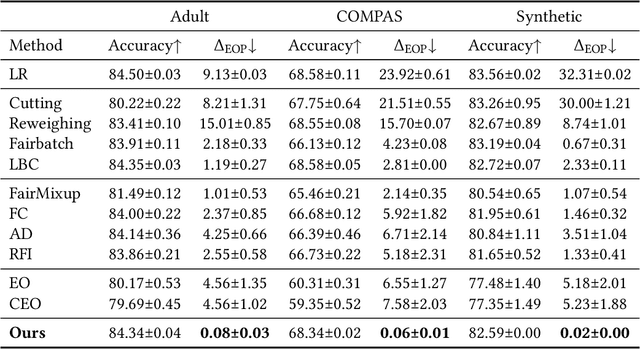
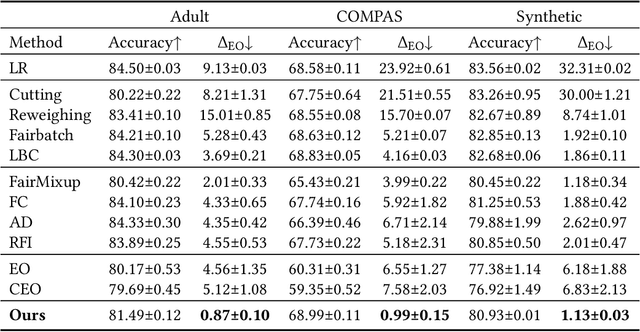
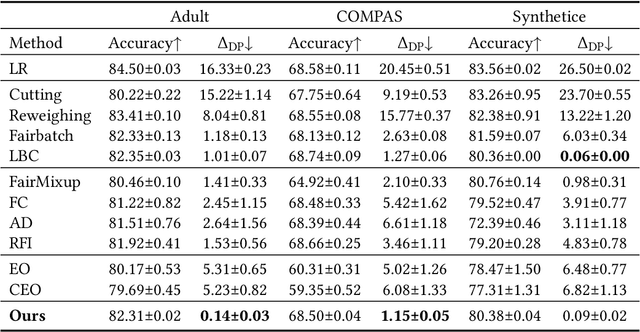
Abstract:With the increasing penetration of machine learning applications in critical decision-making areas, calls for algorithmic fairness are more prominent. Although there have been various modalities to improve algorithmic fairness through learning with fairness constraints, their performance does not generalize well in the test set. A performance-promising fair algorithm with better generalizability is needed. This paper proposes a novel adaptive reweighing method to eliminate the impact of the distribution shifts between training and test data on model generalizability. Most previous reweighing methods propose to assign a unified weight for each (sub)group. Rather, our method granularly models the distance from the sample predictions to the decision boundary. Our adaptive reweighing method prioritizes samples closer to the decision boundary and assigns a higher weight to improve the generalizability of fair classifiers. Extensive experiments are performed to validate the generalizability of our adaptive priority reweighing method for accuracy and fairness measures (i.e., equal opportunity, equalized odds, and demographic parity) in tabular benchmarks. We also highlight the performance of our method in improving the fairness of language and vision models. The code is available at https://github.com/che2198/APW.
Heterogeneous Multi-Task Gaussian Cox Processes
Aug 29, 2023Abstract:This paper presents a novel extension of multi-task Gaussian Cox processes for modeling multiple heterogeneous correlated tasks jointly, e.g., classification and regression, via multi-output Gaussian processes (MOGP). A MOGP prior over the parameters of the dedicated likelihoods for classification, regression and point process tasks can facilitate sharing of information between heterogeneous tasks, while allowing for nonparametric parameter estimation. To circumvent the non-conjugate Bayesian inference in the MOGP modulated heterogeneous multi-task framework, we employ the data augmentation technique and derive a mean-field approximation to realize closed-form iterative updates for estimating model parameters. We demonstrate the performance and inference on both 1D synthetic data as well as 2D urban data of Vancouver.
$E(2)$-Equivariant Vision Transformer
Jul 04, 2023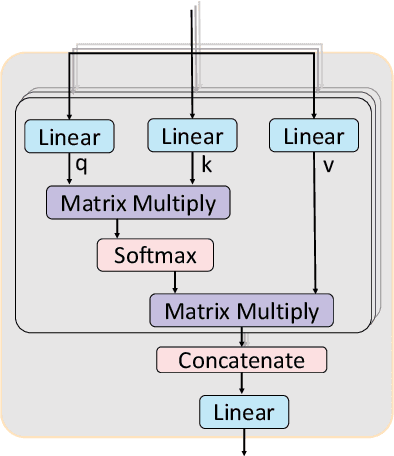
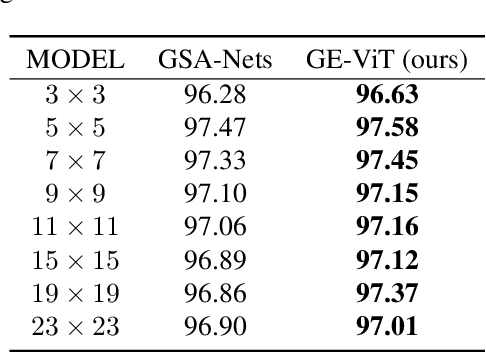
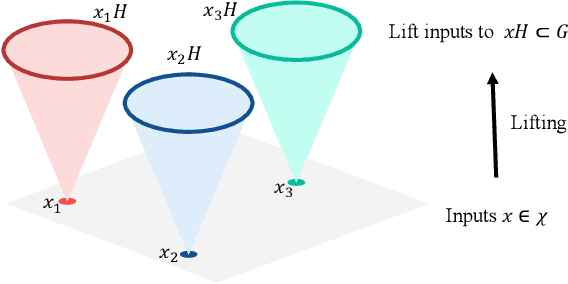
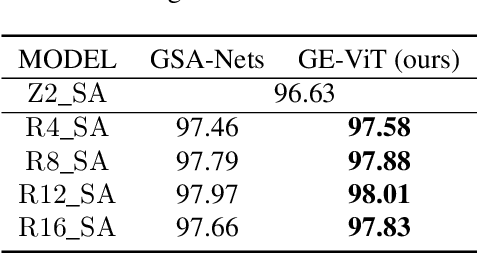
Abstract:Vision Transformer (ViT) has achieved remarkable performance in computer vision. However, positional encoding in ViT makes it substantially difficult to learn the intrinsic equivariance in data. Initial attempts have been made on designing equivariant ViT but are proved defective in some cases in this paper. To address this issue, we design a Group Equivariant Vision Transformer (GE-ViT) via a novel, effective positional encoding operator. We prove that GE-ViT meets all the theoretical requirements of an equivariant neural network. Comprehensive experiments are conducted on standard benchmark datasets, demonstrating that GE-ViT significantly outperforms non-equivariant self-attention networks. The code is available at https://github.com/ZJUCDSYangKaifan/GEVit.
Decentralized SGD and Average-direction SAM are Asymptotically Equivalent
Jun 12, 2023

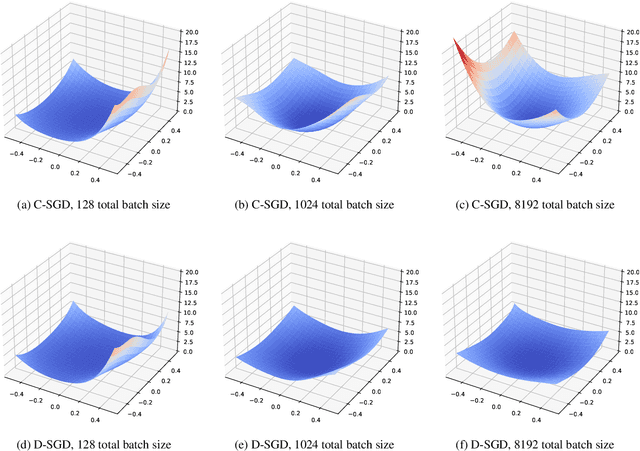

Abstract:Decentralized stochastic gradient descent (D-SGD) allows collaborative learning on massive devices simultaneously without the control of a central server. However, existing theories claim that decentralization invariably undermines generalization. In this paper, we challenge the conventional belief and present a completely new perspective for understanding decentralized learning. We prove that D-SGD implicitly minimizes the loss function of an average-direction Sharpness-aware minimization (SAM) algorithm under general non-convex non-$\beta$-smooth settings. This surprising asymptotic equivalence reveals an intrinsic regularization-optimization trade-off and three advantages of decentralization: (1) there exists a free uncertainty evaluation mechanism in D-SGD to improve posterior estimation; (2) D-SGD exhibits a gradient smoothing effect; and (3) the sharpness regularization effect of D-SGD does not decrease as total batch size increases, which justifies the potential generalization benefit of D-SGD over centralized SGD (C-SGD) in large-batch scenarios.
Human-imperceptible, Machine-recognizable Images
Jun 06, 2023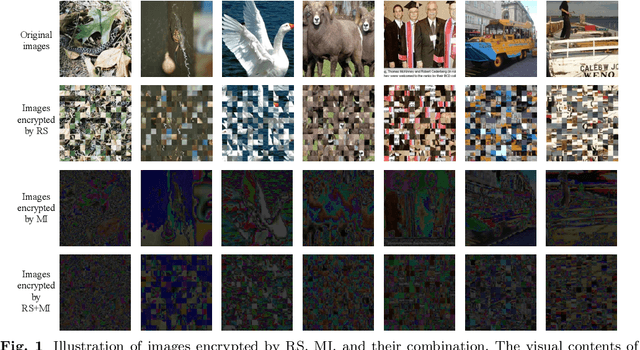
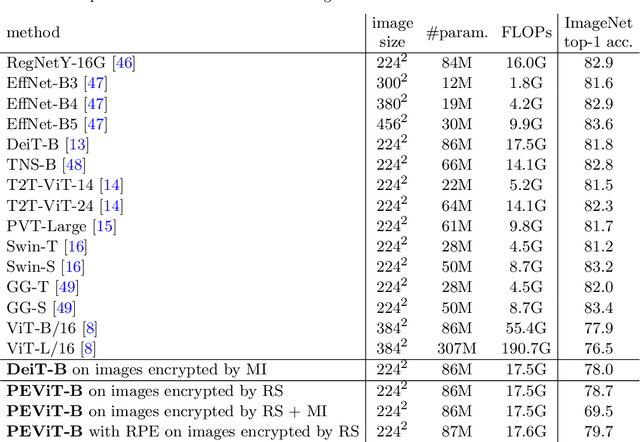
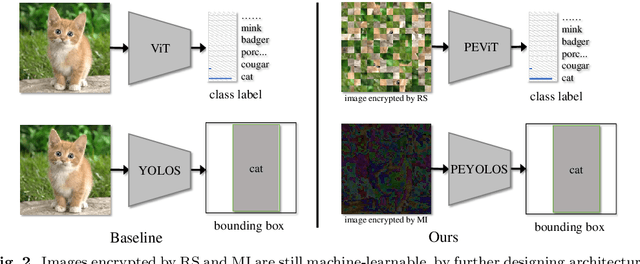
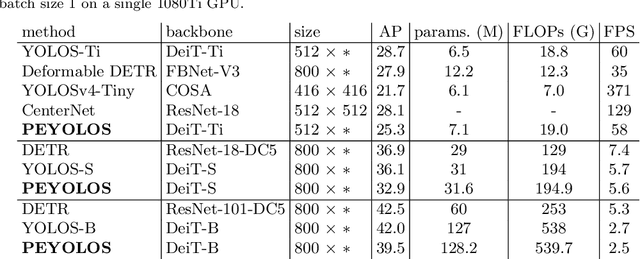
Abstract:Massive human-related data is collected to train neural networks for computer vision tasks. A major conflict is exposed relating to software engineers between better developing AI systems and distancing from the sensitive training data. To reconcile this conflict, this paper proposes an efficient privacy-preserving learning paradigm, where images are first encrypted to become ``human-imperceptible, machine-recognizable'' via one of the two encryption strategies: (1) random shuffling to a set of equally-sized patches and (2) mixing-up sub-patches of the images. Then, minimal adaptations are made to vision transformer to enable it to learn on the encrypted images for vision tasks, including image classification and object detection. Extensive experiments on ImageNet and COCO show that the proposed paradigm achieves comparable accuracy with the competitive methods. Decrypting the encrypted images requires solving an NP-hard jigsaw puzzle or an ill-posed inverse problem, which is empirically shown intractable to be recovered by various attackers, including the powerful vision transformer-based attacker. We thus show that the proposed paradigm can ensure the encrypted images have become human-imperceptible while preserving machine-recognizable information. The code is available at \url{https://github.com/FushengHao/PrivacyPreservingML.}
 Add to Chrome
Add to Chrome Add to Firefox
Add to Firefox Add to Edge
Add to Edge